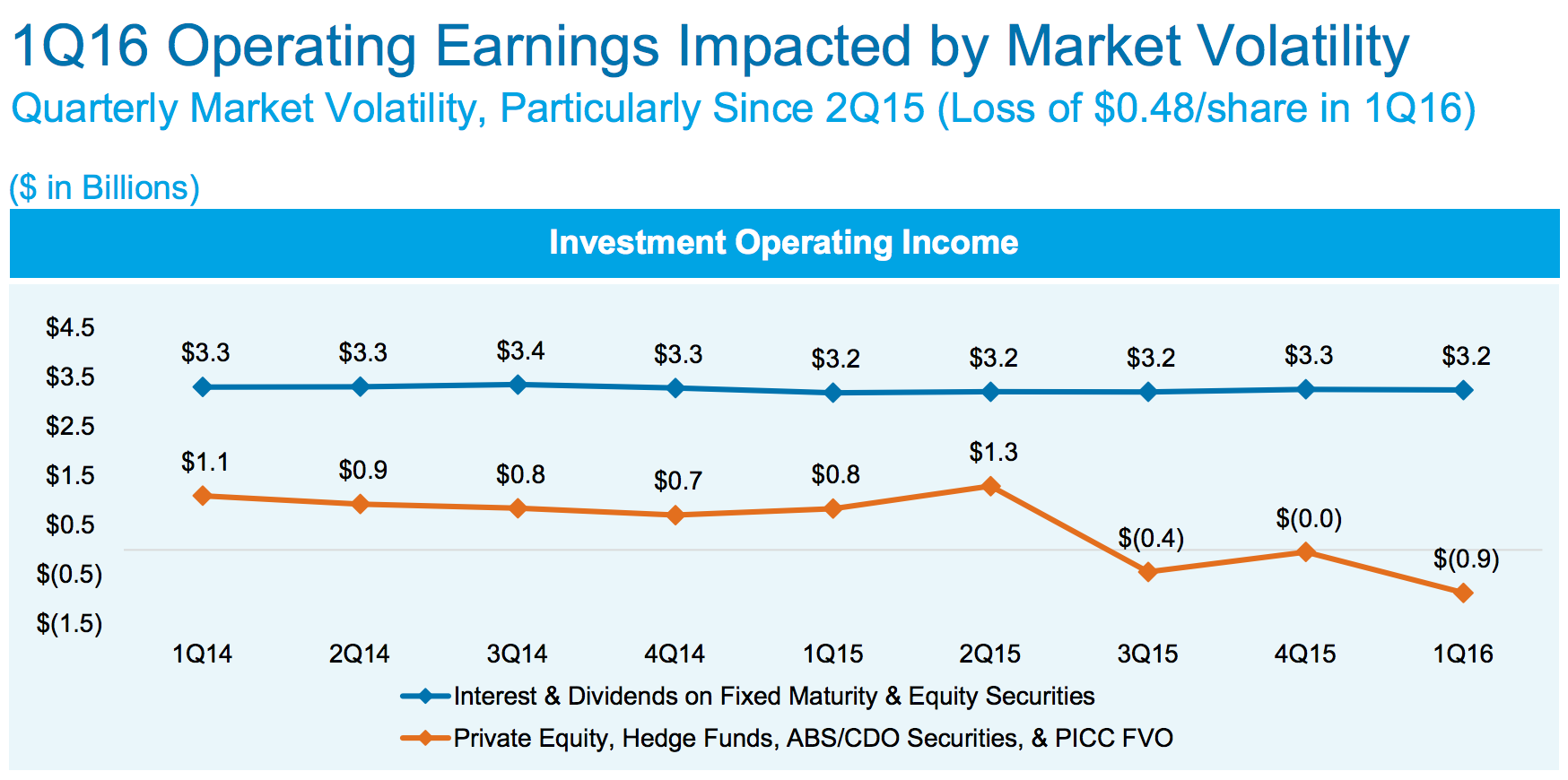Two of the world’s largest insurance companies announced last week they would slash their hedge fund portfolios and redirect their capital.
The reason: hedge funds’ poor and inconsistent returns, largely due to market volatility.
“If the current performance is not attractive, it would be an easy decision to reduce hedge funds.”“It’s had up-and-down years and really it’s just too inconsistent, we think, in actual performance,” MetLife’s CIO Steven Goulart said on the first-quarter earnings call Thursday. “Most of the underperformance [for the quarter] came from hedge funds.”
Negative returns for the first quarter meant the $520 billion insurance giant would redeem $1.2 billion of its $1.8 billion holdings in hedge funds—after it had already pulled $600 million last year. The redemptions would free up cash flow to return more capital from earnings to shareholders, the CIO added.
 Source: AIG
Source: AIG
AIG also revealed last week it would clear $4.1 billion of hedge funds from its books, as part of a plan to halve its exposures. AIG had a $11 billion hedge fund portfolio as of December 2015, or roughly 3% of its total investment coffers of $338 billion.
The insurer said they would reallocate the capital to “contribute about $2 billion to our $25 billion capital return goal through 2017, primarily from the allocation to lower capital charge assets.”
AIG’s hedge fund portfolio suffered losses over the last three quarters, the insurer’s financial statements showed, contributing to direct losses on the balance sheet in each period. The portfolio lost $537 million in the first quarter of 2016 alone, adding to the firm’s net loss of $183 million for the same period.
News of these insurance heavyweights exiting hedge funds makes sense, according to Goldman Sachs Asset Management’s (GSAM) Michael Siegel, but it may not necessarily indicate a larger trend.
“Hedge funds are very capital-intensive to hold,” the global head of insurance asset management told CIO. “If an insurer is thinking about redeploying capital, this is the first place they would look to redeem.”
Broadly speaking, a US life insurance company would hold some 90% of its portfolio in fixed income, and 10% in non-fixed income assets, Siegel continued. The number changes slightly for property casualty firms: 80% in fixed income and 20% in equity-oriented investments.
However, low interest rates and high equity valuations have driven insurers to seek returns elsewhere. They have turned to alternatives—specifically, hedge funds—and their low correlation to fixed income and equities, as well as historically high risk-adjusted returns.
“But if the current performance is not attractive, it would be an easy decision to reduce hedge funds,” Siegel said. “They are more liquid than other assets on the balance sheets, and hedge funds’ earnings come through on a mark-to-market basis—a bad quarter shows up right through the earnings.”
Overall, investors withdrew $14.4 billion in Q1, according to eVestment data, reflecting negative investor sentiment brought on by poor performance in 2015. Focusing redemptions on funds that underperformed last year, investors pulled a net of $15.9 billion in March from these funds, bringing year-to-date redemptions from funds that produced losses in 2015 to $43.4 billion.
Inability to withstand these “inconsistent and short-term” earnings ran across the board, extending beyond insurance companies.
Last month, the largest New York City public pension plan ($55 billion) voted to dump all of its hedge fund investments ($1.7 billion) “as soon as practicable.” Hedge funds charged “exorbitant fees for high-risk and opaque investments,” the pension board of trustees said, and “generally underperformed or lagged the markets.”
In September 2014, the $290 billion California Public Employees’ Retirement System (CalPERS) famously dumped its $4 billion hedgefund portfolio. “At the end of the day, when judged against their complexity, cost, and the lack of ability to scale at CalPERS’ size, the [hedge fund] program is no longer warranted,” CIO Ted Eliopoulos said at the time of the announcement.
Despite the significant exodus, GSAM’s Siegel argued not everyone is fleeing hedge funds.
“We’re seeing insurance companies both deploy capital into and redeem out of hedge funds,” he said. “Insurers investing in hedge funds are now looking for both diversification and strong performance. I don’t think [redemptions] are going to be a massive trend. It’s going to be a year in which net exposures are going to net out to zero.”
Related: AIG Dropping Half Its Hedge Fund Portfolio & MetLife Revises Forecasts, Writes Down Assets as Low Rates Bite
